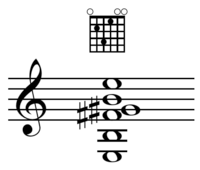Mu chord
| Component intervals from root | |
|---|---|
| perfect fifth | |
| major third | |
| major second | |
| root | |
| Tuning | |
| 8:9:10:12 | |
| Forte no. / | |
|
4-22 / |
A mu major chord or mu chord (signified by μ) is a distinctive voicing of an add 2[2] or "add 9" chord. It is formed by adding a 2nd to a major triad. The mu major chord differs from a sus2 chord as a sus2 chord does not contain a 3rd. The voicing came to be associated with jazz-rock band Steely Dan.
"Inversions of the µ major may be formed in the usual manner with one caveat: the voicing of the second and third scale tones, which is the essence of the chord's appeal, should always occur as a whole tone dissonance."[1] Part of the chord's peculiarity is the presence of two stacked fourths in the upper register, between the second and the fifth, and the fifth and the root. This quartal harmony is more obvious when the chord is voiced with the 3rd in the bass. The chord can also be voiced with the 9th (2nd) in the bass, although such voicings are generally known as slash chords. It is suggested that the chord was conceived on or for use on keyboards.[2]
Mu chords, or portions thereof, may be used in chord substitution to replace simple major triads. For example an Am7 chord can be thought of as a C major triad (CEG) with an A in the bass. A C mu major chord can be voiced as a DEG triad with a C in the bass. Taking the upper portion (DEG) of the C mu chord and substituting this in place of the C triad in the original Am7 chord would give an A7sus4 chord: DEG with A in the bass.[2]
Origin of the name, and separately, the chord itself

The reference to this chord as "mu major" has been popularized by fans of the jazz-influenced rock group Steely Dan, as well as by the band members themselves. This chord is used extensively in their work, often arpeggiated at the end of musical phrases. The "mu major sound" is a distinctive idiom of Steely Dan's style. In a 1989 interview with Paul Zollo,[3] Walter Becker explained that the use of the chord developed from trying to enrich the sound of a major chord without making it into a "jazz chord". Usage of the chord itself had been present for decades in jazz music from bebop to free jazz, and was especially present in the Jazz-funk era from the late '60s to the early '80s. Notable users are, amongst many others and for instance, vibes player/composer Roy Ayers, and pianist/composer Herbie Hancock. The chord/voicing technique was the same, just not named as such.

Sources
- 1 2 3 Becker and Fagen. "Intro to the Steely Dan Song Book ", SteelyDan.com. Posted 05/96.
- 1 2 3 4 Howard Wright 2002-2007. "Steely Dan Mu Major Chord", Howard Wright's Home Page.
- 1 2 "Winter 1989 interview with Walter Becker", Metal Leg: The Steely Dan Magazine, Issue 14, Fall 1990.
Further reading
- Zollo, Paul (2003). Songwriters on songwriting, p.432. Da Capo Press. ISBN 978-0-306-81265-1.
- (2006). Keyboard, Volume 32, Issues 1-6, p.37. GPI Publications.

